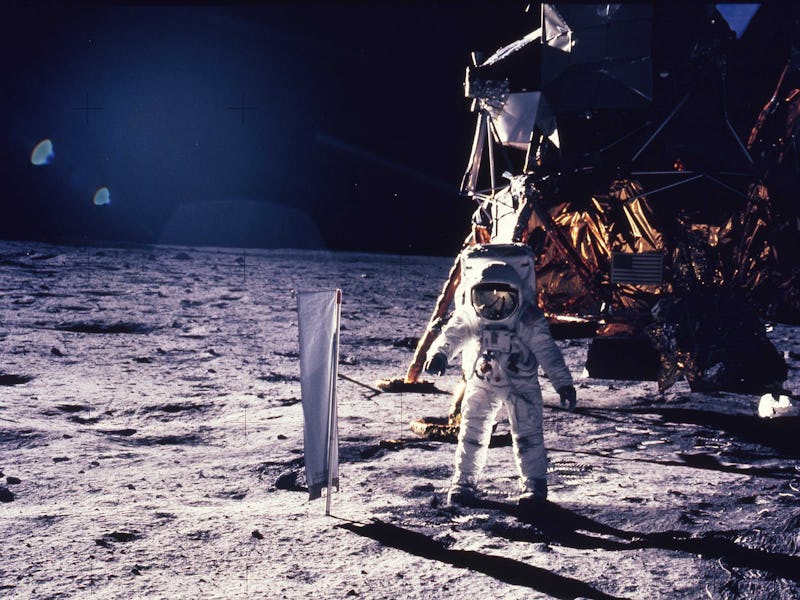Space-wrecked: How we’ve turned the Moon into a junk yard
Lunar landers are one thing, but what about the bags of human waste we've dumped there?

For about 4.5 billion years, the Moon’s dusty, gray surface was pristine, save for a few impact craters and dried up volcanoes.
Enter humans. We came, we saw, we made that giant leap for mankind — and we didn’t pick up after ourselves.
In the last 60 years, humans have accomplished some incredible explorations of our nightly visitor in the sky — but it has also meant that humans have inadvertently turned the moon into a cosmic junk yard. And the more countries that shoot for the moon, the more space-wreck is left behind.
Take the latest moonshot by India: In September 2019, India’s first attempt to land on the Moon ended when the Vikram Lander lost signal. A few days later, amateur astronomer Shanmuga Subramanian located a possible crash site on the lunar surface and alerted NASA.
The impact created by the India lander, spreading debris across the moon's dusty surface.
On December 2, NASA’s Lunar Reconnaissance Orbiter captured the first images of the spacecraft’s debris and the soil disturbance it created around it.
The Vikram Lander was not the first spacecraft to crash into the Moon — we’ve been leaving wrecks and other debris behind us from the very earliest days of lunar exploration.
Here’s some of the other notable pieces of space junk you can find on the Moon:
Holes from different area codes
The first human-made object to land on the Moon was Russia’s Luna 2. On September 13, 1959, the spacecraft intentionally crashed on the lunar surface and self-detonated. The pentagonal plates that made up its soccer-ball shape scattered into the surrounding dust — where they likely remain today.
After Russia, the United States, and China have followed. Israel was hoping to become the fourth nation to land on the Moon. But its Beresheet spacecraft suffered a sudden engine failure, and crashed on the Moon in April, 2019, before it completed its mission.
Israel did achieve a first, though. The spacecraft was carrying thousands of tardigrades, also known as water bears, onboard and the famously resilient species may still be chilling on the lunar surface today.
Tardigrades crash landed on the moon.
More recently, on November 14, the same orbiter that spotted Vikram’s remains also spotted a new lunar crater likely created by a different crash landing on the Moon — although that one was intentional. China’s Longjiang-2 spacecraft dove into the Moon’s surface on July 31 after completing its year-long orbital mission.
Human litter
In 1969, humans made the first footprints on the Moon as part of the US Apollo mission. That event and the subsequent Apollo landings, inspiring as they were, were messy. The Apollo astronauts reportedly left behind bags of urine and poop on the Moon because, well, who wants to fly back to Earth in a spacecraft full of your own waste?
Astronaut Buzz Aldrin, part of the Apollo 11 mission, carries equipment for an experiment on the Moon.
The astronauts also littered the Moon with human memorabilia that may yet teach extraterrestrial life forms about humanity. So, what’s the first thing they would learn about us?
We like to golf.
Astronaut Alan Shephard, who was part of the 1971 Apollo 14 mission, became the first, and possibly last, person to play golf on the Moon. Shephard got one round of golf in, hitting two balls across the lunar surface — and leaving them behind.
A year later, Apollo 16 astronaut Charles Duke left a photo of himself and his family on the Moon, encased in a plastic sealing.
Other things were tossed on the Moon not out of care but out of necessity before the astronauts made their trip back to Earth: the camera they used to feed footage back to NASA headquarters, the tube they carried the American flag in… and four bags of pee and four bags of poop.
This American flag and camera are both examples of some of the objects left by humans on the Moon.
You can read a longer list of the myriad items left behind at the Tranquility Base here, courtesy of New Mexico State University.
As NASA plans to land humans on the Moon as part of the Artemis mission, scheduled for a liftoff in 2024, it’s a new chance for us to add to this cosmic archaeological site — golf, anyone?